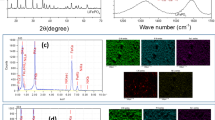Abstract
In this study, LiFe1 − 3x/2Bi x PO4/C cathode material was synthesized by sol–gel method. From XRD patterns, it was found that the Bi-doped LiFePO4/C cathode material had the same olivine structure with LiFePO4/C. SEM studies revealed that Bi doping can effectively decrease the particle sizes. It shortened Li+ diffusion distance between LiFePO4 phase and FePO4 phase. The LiFe0.94Bi0.04PO4/C powder exhibited a specific initial discharge capacity of about 149.6 mAh g−1 at 0.1 rate as compared to 123.5 mAh g−1 of LiFePO4/C. EIS results indicated that the charge-transfer resistance of LiFePO4/C decreased greatly after Bi doping.





Similar content being viewed by others
References
Padhi AK, Nanjundaswamy KS, Goodenough JB (1997) Phospho-olivines as positive electrode materials for rechargeable lithium batteries. J Electrochem Soc 144:1188–1194
Thackeray M (2002) Lithium-ion batteries—an unexpected conductor. Nat Mater 1:81–82
Franger S, Cras FL, Bourbon C, Rouault H (2003) Comparison between different LiFePO4 synthesis routes and their influence on its physico-chemical properties. J Power Sources 119–121:252–257
Anderson AS, Thomas JO, Kalska B, Haggstrom L (2000) Thermal stability of LiFePO4-based cathodes. Electrochem Solid State Lett 3:66–68
Dominko R, Bele M, Gaberscek M et al (2005) Impact of the carbon coating thickness on the electrochemical performance of LiFePO4/C composites. J Electrochem Soc 152:A607–A610
Subramanya Herle P, Ellis B, Coombs N, Nazar LF (2004) Nano-network electronic conduction in iron and nickel olivine phosphates. Nat Mater 3:147–152
Liu H, Cao Q, Fu LJ, Li C, Wu YP, Wu HQ (2006) Doping effects of zinc on LiFePO4 cathode material for lithium ion batteries. Electrochem Commun 8:1553–1557
Lee SB, Jang IC, Lim HH, Aravindan V, Kim HS, Lee YS (2010) Preparation and electrochemical characterization of LiFePO4 nanoparticles with high rate capability by a sol–gel method. J Alloys Compd 491:668–672
Liu YY, Cao CB, Li J (2010) Enhanced electrochemical performance of carbon nanospheres LiFePO4 composite by PEG based sol–gel synthesis. Electrochim Acta 55:3921–3926
Fu LJ, Liu H, Li C, Wu YP, Rahm E, Holze R, Wu HQ (2005) Electrode materials for lithium secondary batteries prepared by sol–gel methods. Prog Mater Sci 50:881–928
Park KS, Son JT, Chung HT, Kim SJ, Lee CH, Kim HG (2003) Synthesis of LiFePO4 by co-precipitation and microwave heating. Electrochem Commun 5:839–842
Yang S, Zavalij PY, Stanley Whittingham M (2001) Hydrothermal synthesis of lithium iron phosphate cathodes. Electrochem Commun 3:505–508
Xuewu L, Hao W, Yuanfu D, Jie T, Zhicong S, Guohua C (2012) Synthesis of sub-micrometer lithium iron phosphate particles using supercritical hydrothermal method for lithium ion batteries. J Shanghai Jiaotong Univ 17(5):517–522
Abbate M, Lala SM, Montoro LA, Rosolenb JM (2005) Ti, Al, and Cu-doping induced gap states in LiFePO4. Electrochem Solid State Lett 8:A288–A290
Zhang W, Yilan H, Tao X et al (2010) Synthesis of spherical LiFePO4/C via Ni doping. J Phys Chem Solids 71:1196–1200
Xu J, Chen G, Teng Y-J, Zhang B (2008) Electrochemical properties of LiAlxFe1 − 3x/2PO4/C prepared by a solution method. Solid State Commun 147:414–418
Hong J, Wang X-L, Wang Q, Omenya F, Chernova NA (2012) Structure and electrochemistry of vanadium-modified LiFePO4. J of Phys Chem C 116:20787–20793
Ferrari S, Lavall RL et al (2010) Influence of particle size and crystal orientation on the electrochemical behavior of carbon-coated LiFePO4. J Phys Chem C 114:12598–12603
Hsu K-F, Tsay S-Y, Hwang B-J (2004) Synthesis and characterization of nano-sized LiFePO4 cathode materials prepared by a citric acid-based sol–gel route. J Mater Chem 14:2690–2695
Ling WU, Zhixing WANG, Xin-hai LI et al (2010) Electrochemical performance of Ti4+-doped LiFePO4 synthesized by co-precipitation and post-sintering method. Trans Nonferrous Met Soc China 20:814–818
Zhang M, Jiao L-F, Yuan H-T et al (2006) The preparation and characterization of olivine LiFePO4/C doped with MoO3 by a solution method. Solid State Ionics 177:3309–3314
Yamada A, Chung SC, Hinokuma K (2001) Optimized LiFePO4 for lithium battery cathodes. J Eletrochem Soc 148:A224–A229
Acknowledgments
This work was supported by the National Natural Science Foundation of China (No. 20771079) and the Priority Academic Program Development (PAPD) of Jiangsu Higher Education Institutions.
Author information
Authors and Affiliations
Corresponding author
Rights and permissions
About this article
Cite this article
Mao, F., Wu, D., Zhou, Z. et al. Structural and electrochemical properties of LiFe1 − 3x/2Bi x PO4/C synthesized by sol–gel. Ionics 20, 1665–1669 (2014). https://doi.org/10.1007/s11581-014-1143-y
Received:
Revised:
Accepted:
Published:
Issue Date:
DOI: https://doi.org/10.1007/s11581-014-1143-y




